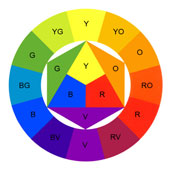It is important how colour behaves with different principles of design. The key design principles are:
Rhythm:

The principle of rhythm provides order and unity in the design. A rhythmic use of colour provides a unified and coherent effect. Repetition an important element of rhythm.

Balance:
Balance relates to overall visual effect of all the components together in a composition or design. Symmetry is the easiest way to achieve balance. Asymmetrical balance is achieved when the components in a composition are not mirrored along the central axis but the balance is achieved by overall placement of the objects in such a way that it creates visual balance.

Proportion and Scale:
The proportion relates to the relationship formed between one part of the design with another part and the overall effect. While the principle of scale looks into size relationships. The scale of the colour used can be judged in two ways 1) the actual colour used. It deals with the amount of colour used in a composition and the amount of surface area occupied by a colour(s); 2) the boldness of the colour used and its scale effect on overall composition.


Emphasis:
It deals with creation of areas of interest or focus for the viewers.

Feisner E. A., (2006) Colour Studies, Fairchild Publication, Inc. NY.
Wong W. ((1997) Principles of Colour Design: Designing with Electronic Colour2nd Ed., John Wiley & Sons.

